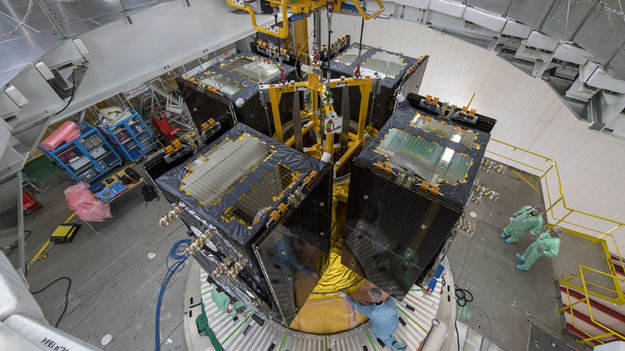The next batch of four Galileo satellites has been put in place on top of the Ariane 5 launcher due to lift the satellites into orbit on 25th July.
The next batch of four Galileo satellites (nos. 23 – 26) has been put in place on top of the Ariane 5 launcher due to lift the satellites into orbit from Europe’s Spaceport in Kourou, French Guiana on 25th July.
The launcher was moved from the BIL Launcher Integration Building, where it was assembled, to the BAF Final Assembly Building, ready for the Galileo satellites to be mated with it. The satellites are manufactured by OHB Systems. They are the first of a batch of eight additional satellites ordered from OHB in June 2017.
In preparation for launch, the four satellites have been switched off, apart from their battery charging line and a maintenance power line to their passive hydrogen maser (PHM) atomic clocks. The satellites, enclosed inside the launcher fairing, will remain under temperature-controlled ventilation under the fairing, with their battery and PHM atomic clock maintenance lines being kept active and monitored continuously until launch.
The PHMs are described by the European Space Agency as the most precise atomic clocks ever flown for navigation, and keeping them powered on in advance of launch serves to maximise their reliability. Each Galileo satellite carries two PHMs plus two rubidium atomic clocks as backups.
The fully integrated Ariane 5 will be rolled out from the BAF to the launch pad on 23rd July. The launch countdown will start around 23:00 local time on 24th July, with launch scheduled at 08:25 local time on 25th July.
This launch will mark Europe’s 99th Ariane 5 flight. The four new Galileo satellites will bring the constellation from 22 to 26 satellites in orbit. The full operational constellation comprises 30 satellites, including six spares. Full operational capability is currently targeted for 2020.

